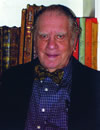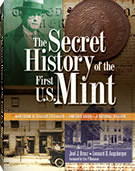
PREV ARTICLE
NEXT ARTICLE
FULL ISSUE
ERIC NEWMAN ON THE PRE-HISTORY OF THE FIRST U.S. MINT
The January 2011 issue of The Whitman Review has a featured column by Eric P. Newman, who wrote the foreword to The Secret History of the First U.S. Mint by Len Augsburger and Joel Orosz. It's a great overview of the history leading up to the creation of the first U.S. Mint. Here's a very short excerpt.
-Editor
It was obvious that having gold and silver coinage minted in Europe was impractical because of the risk of sea transport to the United States. Copper coinage minted in England for the United States was somewhat practical because much copper was produced and refined there. When the first U.S. Mint was under construction in Philadelphia, quantities of copper were purchased from Swedish and English sources, and the U.S. Mint advertised in a Philadelphia newspaper to buy copper. An English source thereafter furnished many copper planchets for the first U.S. Mint. In the thinking for the development and operation of a U.S. Mint, many problems had to be solved. Sufficient water power was not available in Philadelphia or New York or in a future possibility of the new federal capital along the Potomac River. The advantage of steam power was known in America from the successful Boulton & Watt private enterprise in Soho, near Birmingham, England, but the Royal Mint in London had not introduced that type of energy. Steam power in the United States was not then sufficiently developed. Therefore, the first U.S. Mint had to rely on the power of horses and the strength and physical coordination of men, which, although very burdensome, had the virtue of reliability. With mechanical skills available there, the location of choice was Philadelphia.
To read the complete article, see:
Guest Column, January 2011
(www.whitmanbooks.com/Default.aspx?Page=55&HTMLName=ReviewGuest_0111)
The Numismatic Bibliomania Society is a non-profit organization promoting numismatic literature. See our web site at coinbooks.org. To submit items for publication in The E-Sylum, write to the Editor at this address: whomren@gmail.com To subscribe go to: https://my.binhost.com/lists/listinfo/esylum All Rights Reserved. NBS Home Page Contact the NBS webmaster 
|

